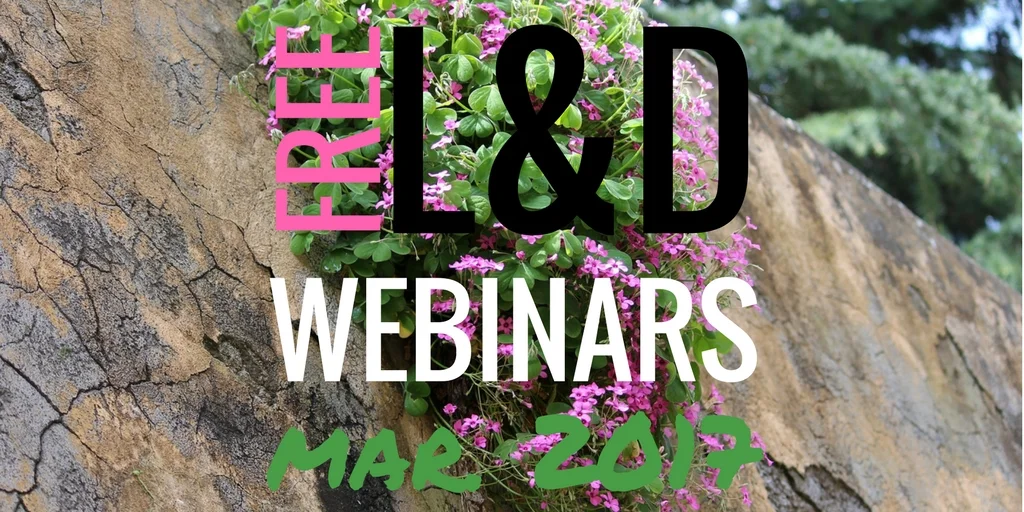How quickly we forget what cold weather is like! Jack Frost has made a sudden appearance and we’re digging out our winter woollies. Why not cuddle up with a hot chocolate and a free webinar or two? We hope these December events will inspire and motivate you.
Tuesday, December 3, 2013, 10AM – 11AM PST: Getting Unstuck: Using Leadership Paradox to Execute with Confidence
Most of the issues that keep us up at night or prevent organizations from being successful are not problems that can be solved. Rather they are paradoxes that need to be managed. Unfortunately, most of us never learned to distinguish the two…or the methods to address the paradoxes.
This program helps people learn the three questions that make the distinction and provides trainers with opportunities to learn a new set of tools, language, and skills that can become part of their toolkit to help individuals and organizations address longstanding obstacles to success—so they can become more resilient and successful over time.
Tuesday, December 3, 2013, 11AM – 12PM PST: 5 Tips for Turning Gamification Theory into Practice (Free for ASTD members)
You’ve heard all about gamification for learning, but how do you take the elements of gamification and make them a reality within your organization? This webinar, based on Karl Kapp’s newest book, The Gamification of Learning and Instruction Fieldbook: Theory into Practice, provides answers for turning your ideas into reality. The webinar will cover five practical elements for gamification and a step-by-step approach for implementing gamification concepts. This discussion will include several examples, lots of tips, a couple of tricks, and a worksheet or two to help learning professionals put the ideas into practice and gamify their content.
Wednesday, December 4, 2013, 11AM – 12PM PST: Managing a Virtual Workforce (Free for ASTD members)
Do you or your employees work outside of a traditional office? This might mean working from home on occasional mornings or being completely based at your local coffee shop. Perhaps you supervise sales staff in a large geographic area or are responsible for a team of global technology professionals. Mobile workforces are a growing and permanent trend, and management strategies need to keep pace.
This webcast will provide the basics of managing your mobile workforce—from supervisory tools to leadership techniques. You will be presented with the bedrock of a successful virtual work arrangement, including the four questions to ask yourself before deciding if a virtual work arrangement is right for your job position. Discover how to better engage employees working offsite and how to reinforce your corporate culture. Finally, learn how to optimize technology to coach and counsel employees working in the virtual cloud.
Thursday, December 5, 2013, 10AM – 11AM PST: Leaving ADDIE Behind – A Conversation with Michael Allen
Analysis, design, development, implementation, and evaluation (ADDIE) are all important steps in the design of effective eLearning applications or any learning program. While there have been many adaptations of ADDIE, many of them were made before we had today's tools, challenges, and opportunities. Join Dr. Michael Allen for a candid conversation with Richard Sites as they casually discuss what’s needed and possible today leveraging Agile to improve development efficiencies and effectiveness—resulting in the best learning experiences possible.
Thursday, December 5, 2013, 10AM – 11PM PST: 5 Reasons Why You Can't Ignore Gamification (Free for ASTD members)
Gamification is more than newfangled training. It is touted as the next form of work-based social media, in which people interact and socialize around a common bond of knowledge, competitive strategy, and fun. Elements of game play engage employees with just about any topic: improving operations, cutting logistics costs, and challenging employees to understand how their roles contribute to enterprise success. Many of the world’s largest brands are deploying gamification, including Coke, AOL, Nissan, Nike, and Viacom, and as more studies become available, the advantages to gaming in the workplace will become widespread. One primary lever promoting gamification is that employee satisfaction, which is closely related to employee retention, can no longer be achieved through financial compensation alone. The challenge now is to understand why gamification is so effective and how to introduce it seamlessly into an organization.
Thursday, December 5, 2013, 10:00AM – 11:00AM PST: Mobile Learning in Practice
Organizations taking their first steps into mobile learning can easily become overwhelmed by the multitude of considerations that exist: multi-device learning, responsive design, delivery platforms, tablets, smart phones, app stores, and much more. Without the benefit of practical examples and proven experience, it can be difficult to see how different approaches will work in practice, or to decide what will work best for your organization or sector. This webinar looks at the following:
- Just-in-time learning
- Games-based learning
- Multi-device eLearning courses
- On-the-job support and training
Tuesday, December 10, 2013, 10AM – 11AM PST: Virtual Presentations That Work: Breakthrough to Engage Clients and Staff
It’s one thing to be clear, concise, and in control of your message when you’re speaking to a group of people in a live conference room setting. It’s an entirely different thing to keep audience members attentive and engaged when presenting virtually. It’s not just learning how to run the meeting software. That’s the easy part. The real issues are getting people to want to participate and communicating well using the technology so that what you say is actually heard and understood. In this practical session, delivered virtually, you’ll explore the skills and techniques it takes to communicate effectively in virtual settings no matter whether you’re conducting meetings, presentations, product demos, or video conferences.
Tuesday, December 10, 2013, 12PM – 1PM PST: Capitalize on the Power of Employee Engagement in Government/Leveraging the Power of Employee Engagement (Free for ASTD members)
This is not an easy time to be working in the public sector. Heated budget battles and rhetoric about the size, function, scope, and effectiveness of government have generated criticism not just of government but also of the public servants who deliver government services. Across the country, government agencies and their employees are being denigrated and stigmatized. One proven response to maintaining effectiveness in this difficult environment is to improve the level of employee engagement. Research has clearly and convincingly shown that improving employee engagement will drive higher levels of organizational performance, reduce turnover, and yield other important workforce benefits. This session will focus on empirically proven approaches to improve employee engagement in government agencies.
Wednesday, December 11, 2013, 10:00AM – 11:00AM PST: Leveraging Technology for Social Learning
Social media has become a fixture in many of our lives, whether it be Facebook, Twitter, LinkedIn or any other of the growing list of social technology platforms. Using technology to facilitate the natural connections and interactions between learners, instructors, and content is becoming the norm. The key is to recognize the difference between social media and social learning, and to know what social media is and isn’t. Webinar topics include:
- The evolution of learning
- The difference between social learning and social media
- Current trends in social learning technology
- The possibilities of social and mobile
- Examples of social learning environments
Wednesday, December 11, 2013, 11AM – 12PM PST: 3 Ways to Increase the Enrollment, Engagement, and Effectiveness of Your Training through the Power of Story
As trainers, we focus extensively on the design and development of our training content. Yet sometimes, even if we follow instructional design principles to the letter, our content doesn't engage, wow, or connect with the audience. What’s the missing ingredient? Join this webinar with author and training expert Pam Slim to discover how powerful, relevant, and engaging stories can humanize and accelerate the learning experience. Learn:
- How to create compelling copy that boosts class sign-ups
- Three story frameworks for simplifying your work and electrifying your audience
- How to weave a story thread through your entire training experience
Wednesday, December 11, 2013, 11AM – 12PM PST: Leveraging Mobile Learning for Sales Enablement (Free for ASTD members)
Join us for an exploration of how mobile devices can be leveraged to augment and support sales professionals, since they are often the most mobile team members who require training and performance support. New instructional design patterns for creating superior sales tools, job aids, and learning experiences for tablets, smartphones, and SMS-enabled feature phones will be explored in this how-to-focused webinar featuring content from the upcoming ASTD Infoline of the same title.
Thursday, December 12, 2013, 10AM – 11AM PST: Crowdsourcing: The End of Administrative Onboarding
The days of administrative onboarding are numbered. Hiring priorities continue to evolve, and it’s become increasingly apparent that traditional onboarding—wherein new hire orientation is often limited to a list of HR to-dos—isn’t meeting today’s talent needs. Leaders of high-performing organizations are actively looking for ways to combat new hire turnover and foster new levels of employee engagement—and they’re overhauling onboarding to do it. But success in onboarding is not guaranteed. In order to achieve real and lasting results, there are important questions that need answers—not the least of which is, “Where to begin?” This webinar discusses:
- Understanding the talent trends driving the end of administrative onboarding
- Case studies on the real business impact of improved onboarding processes
- Tips for leveraging crowdsourcing techniques to breathe new life into traditional onboarding practices
Thursday, December 12, 2013, 10AM – 11AM PST: Push Learners to the Edge with Story-Driven Games
How do you get the learner involved in the discovery of ideas? How do you ensure the learner is paying attention? PUSH THE LEARNERS TO THE EDGE. It may sound unorthodox, but this is how people learn best—being on edge, rushing to get things done, stretching their capacity to overcome an obstacle. These are traits of an active learner. The challenge is how to structure a learning environment so that it constantly pushes learners to the edge. In this session, you’ll see demos of story-driven games, and learn:
- The basic rules that guide the design of high-pressure and high-discovery learning games
- How to use stories to super-charge the tension and escalation of the learner’s discovery experience
- How to pitch the learner into a game so that content is learned while playing it
- How to add surprises, intrigue, tension, twists, curiosity, and passion in the learner to play the game
Thursday, December 12, 2013, 10AM – 11AM PST: You Can't Lead If You Can't Communicate: Simple Techniques to Get Your Message Across (Free for ASTD members)
Mike Figliuolo is a recognized presenter and author on developing leadership and communication skills in the workplace. He is an Honor Graduate of the United States Military Academy at West Point and he served as an armor officer in the U.S. Army. Mike has held positions as a consultant with McKinsey & Company and as an executive at Capital One Financial and Scotts Miracle-Gro. He is the founder and managing director of thoughtLEADERS, LLC—a leadership development training firm that focuses on real, practical, and applicable knowledge. His book One Piece of Paper: The Simple Approach to Powerful, Personal Leadership is designed to help leaders define who they are and what their personal leadership philosophy is. Mike is specifically known for his programs that take participants beyond theory to hands-on application for immediate results.
Friday, December 13, 2013, 11AM – 12PM PST: State of the Industry, 2013 (Free for ASTD members)
Laurie Miller, Director of Research Services at ASTD, and David Frankel, Research Specialist, will discuss benchmarking data from ASTD BEST Awards Winners, Fortune magazine's list of Global 500 (G500) companies, and other organizations from 2004 to the present. ASTD estimates that US organizations spent $1,195 per employee on learning and development in 2012. The content from this webcast is drawn from ASTD's 2013 State of the Industry report, which is sponsored by Skillsoft and CARA.
Monday, December 16, 2013, 11AM – 12PM PST: BEST Webcast Series: University Health System: How to Create and Sustain Buzz in Your Learning (Free for ASTD members)
Building a strong, compelling brand for the learning and development department is essential in today’s workplace. With competing and escalating demands on time and talent, L&D must craft and implement a strategy to demonstrate its value. Learn how University Health System uses executive support, marketing communication, ROI, awards and recognition, partnerships, and more to create and sustain learning. Three things participants will take away:
- Examples of ways to create and sustain buzz
- Ten benefits to submitting awards applications
- The essence of a branding strategy for your learning development
Tuesday, December 17, 2013, 9AM – 10AM PST: Managing the Matrix: Hilton's Journey of Launching their School of Sales (Free for ASTD members)
When Joe Anzalone, director of the school of sales at Hilton Worldwide, was tasked with launching a common global sales learning function in the spring of 2012, he was greeted with a series of obstacles—decentralized decision making, nine different sales training programs already in use, competing leadership priorities and agendas, and a legacy of skepticism about previous US and corporate-based learning solutions. Join Joe as he walks you through his experiences dealing with these daunting challenges, how he has been able to overcome them, and what the future holds for Hilton’s global school of sales as the journey continues.
Wednesday, December 18, 2013, 10AM – 11AM PST: Research Spotlight: Learning Strategies and Mobile Learning
This installment of Brandon Hall Group Research Spotlight webinars walks through BHG’s latest research on mobile learning and shares some preliminary data from the recently closed Learning and Development benchmarking survey. This webinar will include:
- Statistics on the maturity of mobile learning
- Effectiveness ratings for various types of mobile learning
- Research into the development of learning strategies
- Research into learning and development budgets
- Highlights of award-winning case studies from the 2013 Brandon Hall Group Excellence Awards
Wednesday, December 18, 2013, 10AM – 11AM PST: eLearning Authoring Tools: What’s Important?
What asynchronous eLearning authoring tools do individuals and organizations use and want, and why? What are the most desired features in asynchronous eLearning authoring tools at the macro and micro levels? These are the two overarching questions addressed in The eLearning Guild’s new survey-based research report, eLearning Authoring Tools 2013: What We’re Using, What We Want. In this webinar, you will learn:
- About the most important and most desired eLearning authoring tools
- About the most important features of these authoring tools
- What our panel of experts thinks of the survey results
























